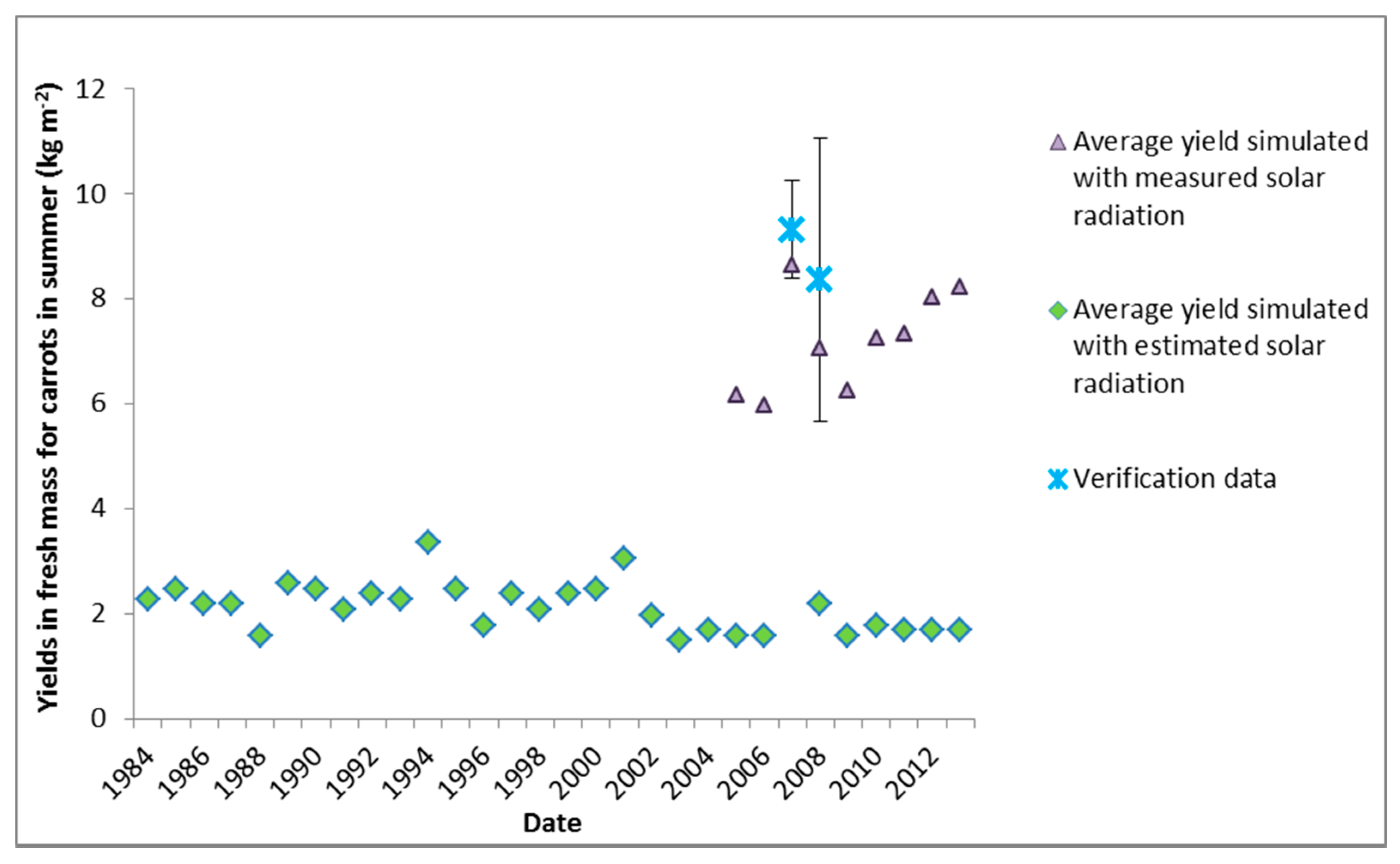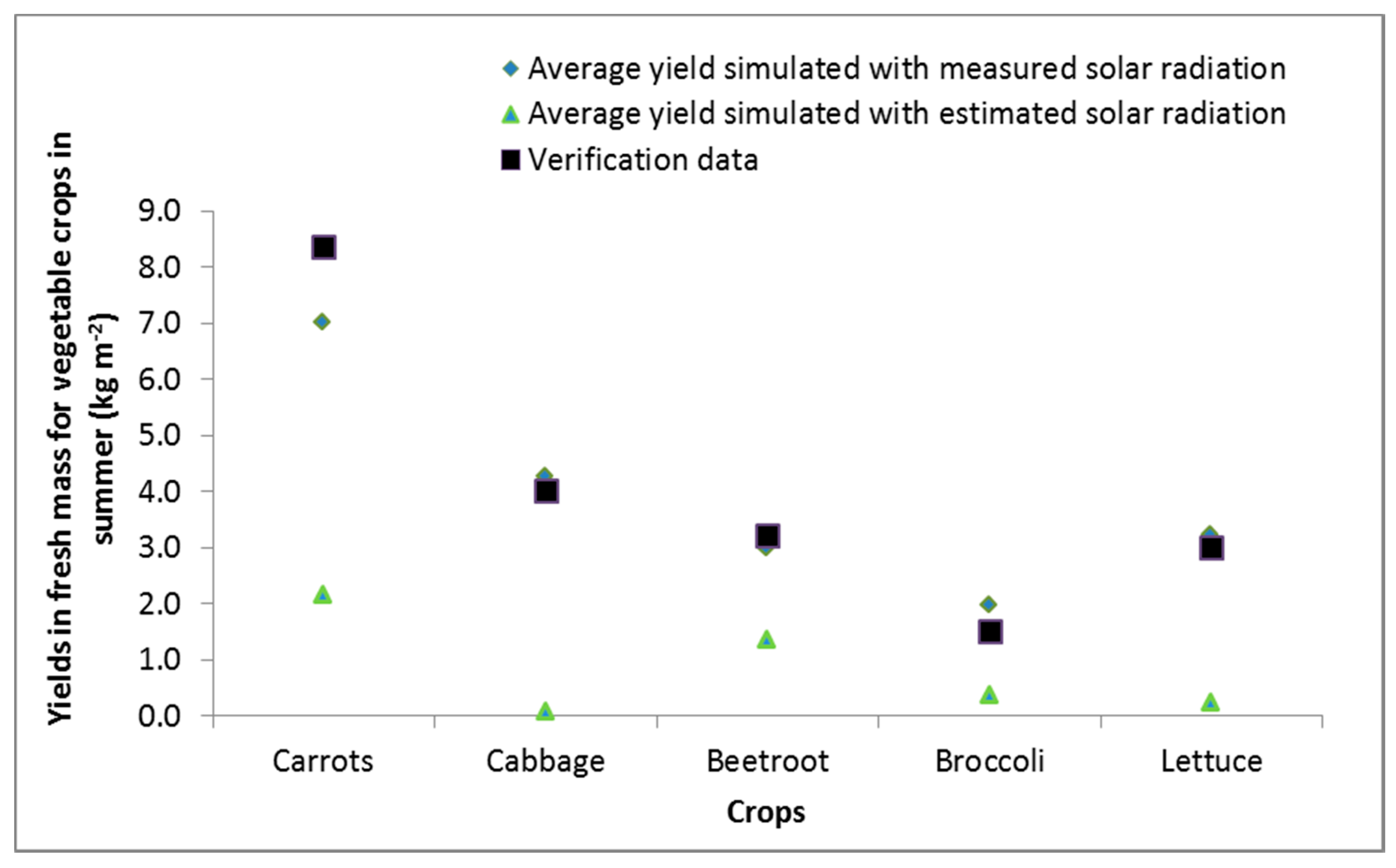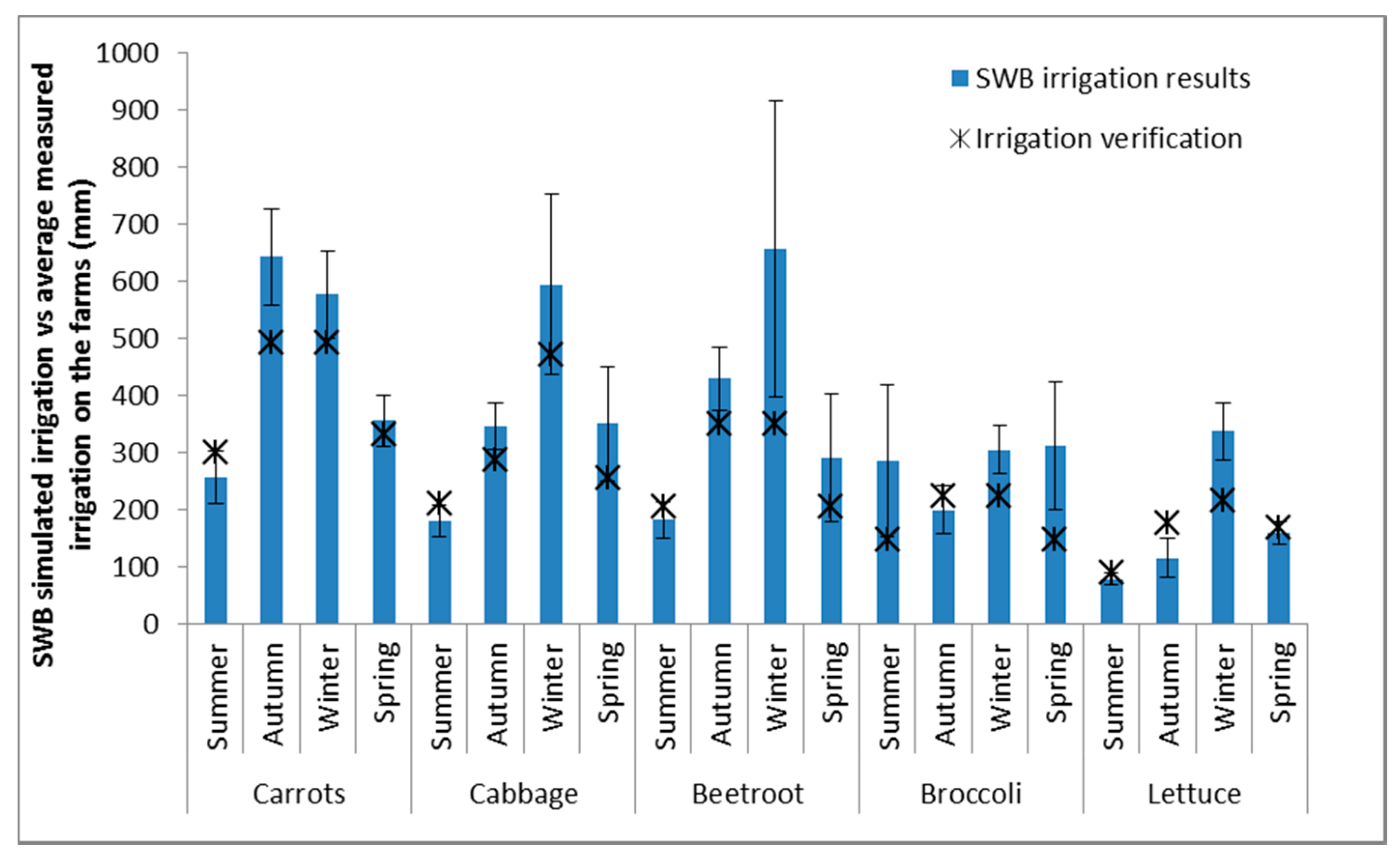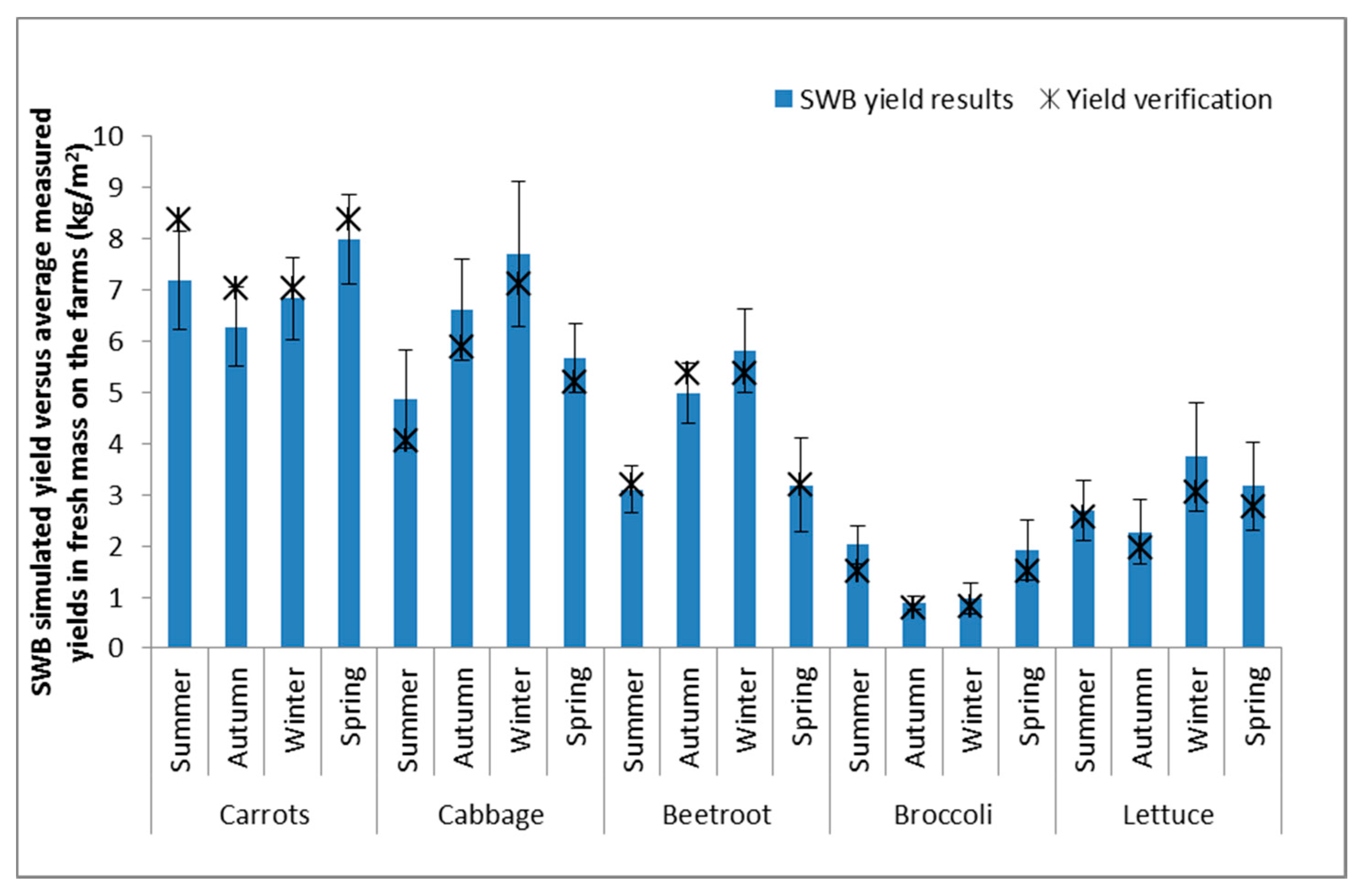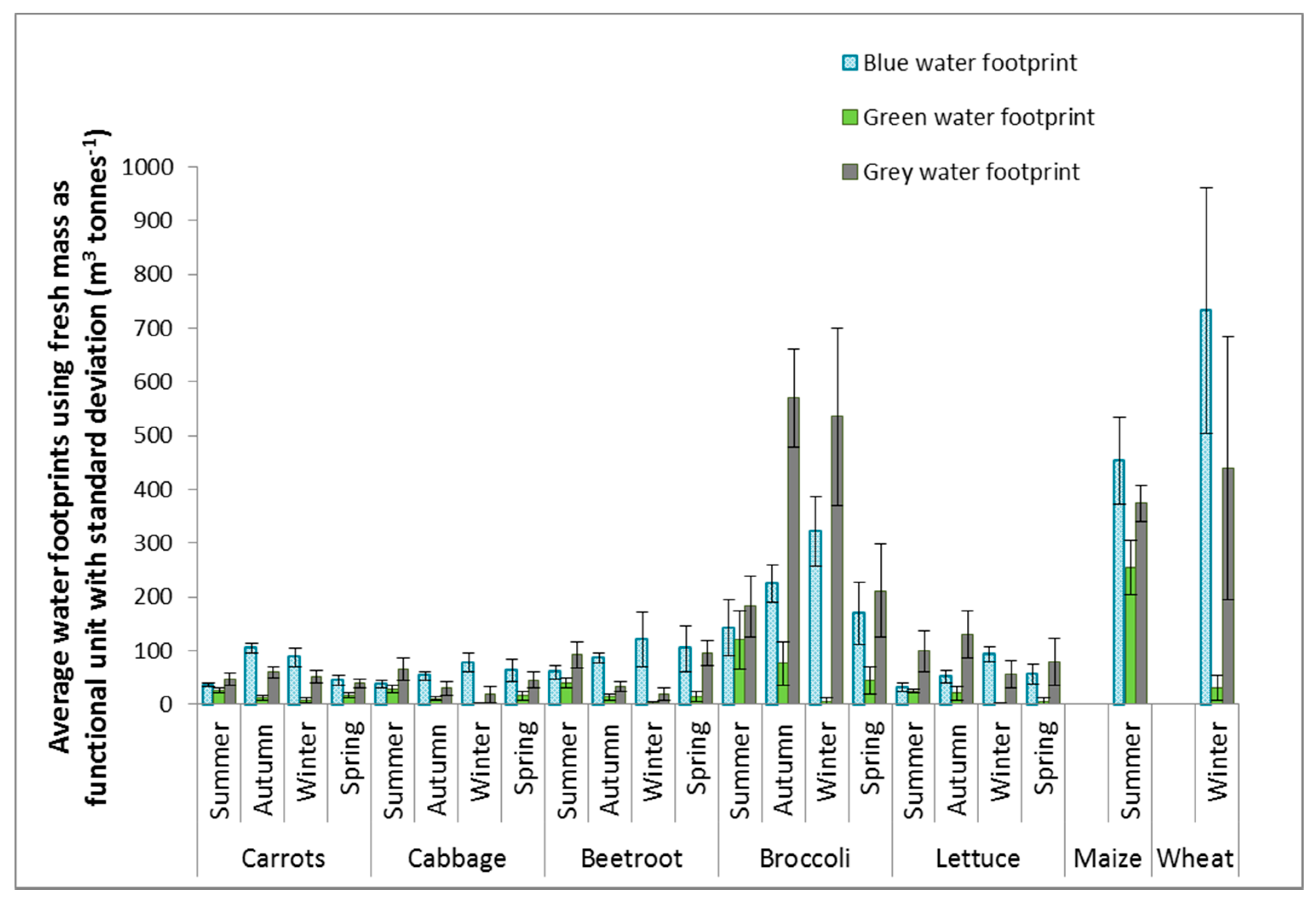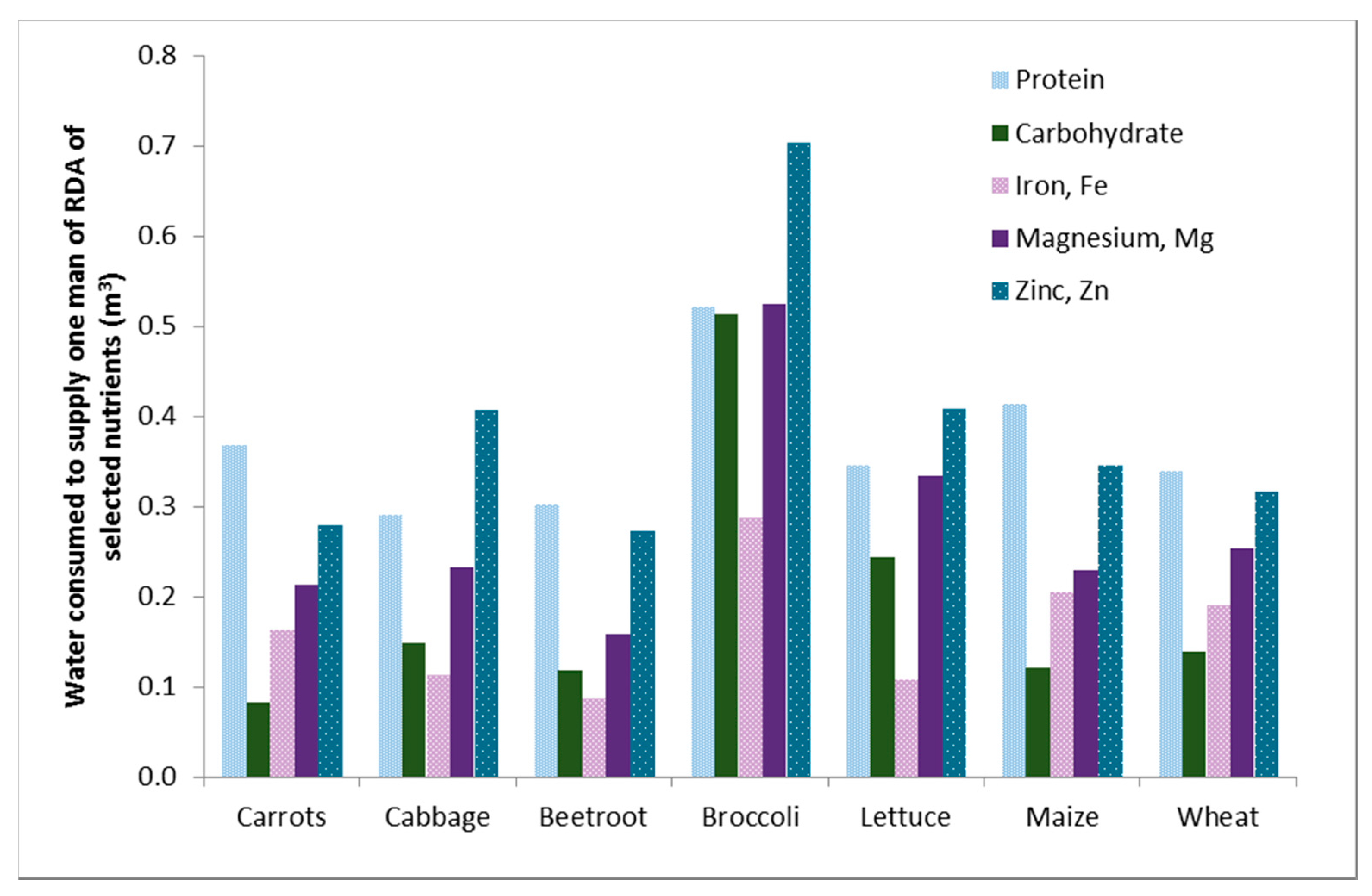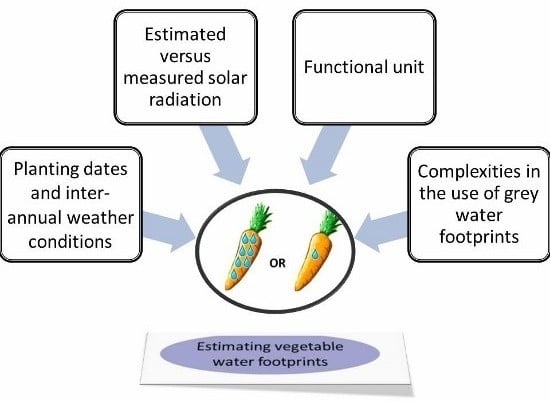1. Introduction
In many catchments throughout South Africa, water supply no longer meets demand [
1]. Climate change, population growth and improved standards of living will exacerbate this even further in the future. Irrigated agriculture uses approximately 40% of South Africa’s exploitable runoff on around 1.7 million hectares of land [
2]. Agricultural products account for approximately 6.5% of total South African national exports, approximating 3% of gross domestic product [
3]. Nieuwoudt et al. [
4] estimated that 90% of vegetable and fruit products are grown under irrigation in South Africa because of low and erratic rainfall and the high value of these crops. Horticulture is therefore highly dependent on the continued availability of irrigation water to remain sustainable. However, surface water resources in South Africa are already almost fully developed, and although alternative sources can still be exploited, it will be done at significantly higher costs than previously [
1]. The vulnerability of food production in South Africa was emphasized by the drought of 2015 which was, according to the South African Weather Bureau, the driest calendar year since nationwide recordings started in 1904 [
5]. As a result, preliminary estimates on crop production for the 2016 calendar year indicate that production of most crops is expected to decrease [
6]. One of the key findings of the Water Resource Reconciliation Strategies for major cities and towns in South Africa, was that little additional surface water can be made available to agriculture in the future, and that many areas are already considering the re-allocation of irrigation water to other users [
1]. The “Reconciliation Strategy for the Crocodile West Water Supply System”, for example, suggested that leakages in the distribution network of irrigation water from the Crocodile Catchment should be addressed and that this water be reallocated to augment water requirements of the rapid developments in the Lephalale area or for urban and rural use [
7].
Water Footprint (WF) accounting is an emerging approach first proposed by the Water Footprint Network (WFN) in 2002, aiming to better quantify the impacts of human activities on water quantity and quality and guide improved decision making and management. Hoekstra et al. [
8] distinguish between “blue”, “green” and “grey” WFs. Surface and underground water resources, which are available to multiple users, are defined as blue water. In a crop production context, blue water consists predominantly of the irrigation water applied. Green water originates from rainfall that is stored in the soil and is only available for evapotranspiration (ET). In order to account for water quality impacts, the WFN [
8] proposed the concept of a grey WF, which is the volume of water required to dilute pollutants to naturally occurring levels. Water footprints can indicate water consumption, defined as the loss of water from a particular catchment, for example through evaporation or transfers to other catchments, along the entire production chain per yield of product [
8]. Whereas traditionally the focus has been on agricultural producers and the technical aspects of irrigation and drainage to reduce impacts on freshwater resources, WFs further potentially allow water issues to be addressed through regional trade policies and consumer attitudes [
9]. Water footprint accounting also has the potential to provide crop water use metrics in an easily understandable way, which can assist farmers to improve the management of their water resources by informing production decisions. If WFs can be established for a number of well-managed farms, these could serve as benchmarks that can be used by other farmers to improve their blue, green and grey water footprint. Efficient use of green water in agriculture is essential to minimize the exploitation of blue water resources for irrigation. Over-irrigation is undesirable, because it can result in water logging, soil salinization, groundwater pollution, leaching of nutrients, and other impacts on the soil [
10,
11,
12].
A number of studies have been conducted on the WFs of various crops, for example the WFN calculated the WFs for several crops from global databases at a 5 by 5 arc minute grid [
13]. In South Africa, WFs have been calculated for the cultivation of various crops, including the vegetables cabbage, tomatoes, spinach, potatoes and green beans cultivated under different smallholder irrigation schemes [
14], for lucerne as livestock feed for milk production [
15], for sugar cane [
16] and for the biodiesel crop
Jatropha curcas [
17]. A product WF was calculated for producing beer by SABMiller in South Africa [
18]. WFs have been calculated for agriculture in the Breede Water Management Area [
19], and for South Africa as a whole [
20]. These studies indicated that WFs can potentially be a useful tool to quantify direct and indirect water use, with its flexibility being particularly advantageous, as it can be applied to various entities, including products, consumers, businesses and catchments [
21]. WF were also found useful to assess water used in terms of economic gains and job creation [
19], and to inform policy making to improve sustainable development [
20]. The importance of calculating WFs with local data and interpreting WFs within the local context has been emphasized [
14,
15].
The Steenkoppies Aquifer is located west of Tarlton, South Africa, and is a major vegetable producing region in Gauteng. During the 1980s, agricultural activities on the Steenkoppies Aquifer increased dramatically, sourcing irrigation water from the aquifer through boreholes. The discharge of surface water from the aquifer was drastically reduced as a result [
22], which caused conflict between farmers on the aquifer and downstream users [
23].
This research was conducted as part of a Water Research Commission (WRC) project [
24] on WF accounting, aiming to better understand the potential intricacies involved in calculating WFs of vegetable crops using a case study on the water stressed Steenkoppies Aquifer. In this paper, we report on how WF outcomes are influenced by several factors, including natural variations in weather conditions between growing seasons and between different years. Water footprints are also directly dependent on crop simulation model outputs, which are in turn affected by the quality of parameterisation and input data used, including weather data. Variations in water content between different crops can impact the WFs, which are most commonly expressed as a volume of water used per yield in fresh mass, and we explore the impact of functional units on the results. Finally, some complexities in using the grey WF method are discussed, and aquifer water quality measurements used to challenge the calculation of grey WFs.
4. Discussion
Although WFs can provide very useful information in an agricultural context, there are still challenges involved in calculating WFs, interpreting the information and understanding the limitations of the information that need to be addressed. The aim of this study was to better understand the complexities involved in calculating WFs for short-season vegetable crops.
A number of studies in the literature have reported different WFs due to spatial and annual variation in weather conditions [
13,
63,
64]. Inter-annual variation in blue, green and grey WFs of maize production in Beijing was found to be related to changing climate and agricultural management practices [
64]. Blue WFs increased and green WFs decreased as a result of both drier climates and intensifying agricultural inputs. Multsch et al. [
63] reported increased green WFs in high rainfall parts of the High Plains Aquifer (HPA) and increased blue WFs in parts of the HPA with low rainfall and higher temperatures. By calculating average WFs for crops from 1996 to 2005, Mekonnen and Hoekstra [
13] recognised the inter-annual variation in WFs of crops. Our results show that it is also important to interpret WFs with specific reference to the growing season, especially for short season crops with a range of planting date options. High inter-annual variation for this case study was illustrated by the WF high standard deviations of some crops during certain growing seasons, for example broccoli in summer with an average blue plus green WF of 262 m
3·tonnes
−1 and a standard deviation of 105 m
3·tonnes
−1.
It should be widely recognised that WF estimates can be significantly influenced by the quality of data used to parameterise and run crop models. We observed that daily ET
o estimates can differ significantly when either measured or estimated solar radiation data is used for its calculation, so we recommend that consistent weather data be used from parameterisation (creating crop parameters) to model application (using crop parameters for model simulations to obtain outputs). This was observed particularly for solar radiation during summer and spring for our study region. Using estimated solar radiation data for crops planted in autumn and winter, however, resulted in smaller differences in ET
o and yield estimates. Therefore, the consistency in weather data that is used could potentially have a significant impact on WF results. Zhuo et al. [
65] obtained similar results with a sensitivity analysis of WFs of maize, soybeans, rice and wheat to errors in input variables. They found that WFs of these crops are particularly sensitive to variations in ET
o. The comparison between WFs calculated using more generic data from Mekonnen and Hoekstra [
13] as given in
Table 5 not only highlights the importance of reporting WFs for a specific season, it also highlights the need to use local data where possible, for example to parameterise a specific crop. All WFs reported by Mekonnen and Hoekstra [
13] had a higher green and lower blue WF, while WFs generated using more detailed local data had a higher blue and lower green WF. This is due to the study area being located in the dry summer rainfall high central plateau of South Africa. The study area is considered to represent other areas in South Africa and around the world with similar climatic conditions.
The functional unit used to calculate WFs has a significant impact on WF metrics. Grains with low moisture content, such as maize and wheat, will have a disproportionately high WF compared to vegetables when using fresh mass yields. Depending on the objective of the study, different functional units for various crops can be used to reveal which crops will be more efficient in producing important nutrients per volume of water. Assessing WFs in terms of other functional units such as economic gain and job creation is recommended for future research, because these alternative assessments can provide important information on how to allocate limited water supplies to achieve various objectives.
The high WF of broccoli due to the low relative yield of the harvestable portion that is produced by the crop presents a complexity and potential drawback in the application of the WF information, because the rest of the plant is often used for composting or animal feed. It can be argued that the beneficial use of the rest of the plant increases the total yield, and should be reflected in the WF. This could also be the case for many other crops. Compost will be incorporated into and increase the yield of the next crop and benefit soil health and the long term sustainability of the system. Therefore, composting the non-edible part of the previous crop will potentially reduce the WF of the next crop. It can also be argued from a different point of view if one uses compost to reduce the need for fertilisers. Production of fertilisers will have a certain WF and the compost will reduce the WF of the crop by reducing the need for fertiliser and the water required to produce the fertiliser. The blue, green and grey WF of fertilisers has not yet been addressed. Composting can also reduce the grey water footprint, because the use of organic N will potentially reduce the need for inorganic N and create N use efficiency.
The grey WF is a way of reporting impacts on water quality, which is a very important aspect of water resource management. The concept has, however, often been criticized for being too simplistic [
66,
67,
68]. In a crop production context, water pollution is an especially complex issue. There are uncertainties in the determination of the N load leaching into the aquifer, because the fate of N is not well understood. Phosphates, salts, sediments and pesticides are also pollutants associated with agriculture, and need to be taken into account when addressing water quality. Therefore, it is not completely effective to assess the water quality impacts based on one pollutant. Similar to the WFs based on different nutrients, the grey water footprint can be calculated for various pollutants and the highest WF can be used as the total. The intensive use of fertilisers and the vulnerability of the aquifer to pollutants, as indicated by Witthueser, et al. [
69], suggested that some impact could be expected on the water quality due to cultivation of crops. However, water quality analyses of the underlying groundwater indicated very good quality water, despite the intensive farming that has occurred over the past few decades. It is clear that the process of water pollution and pollutants leaching into the groundwater in the Steenkoppies Aquifer is still not well understood. A simplified method such as the grey WF does not provide the necessary information to improve water quality management of an aquifer. The use of grey WFs also becomes complex in a crop production context in cases where compost is used. Future research needs to address the potential benefits of composting crop residues in terms of the grey WF.
Despite the complexities addressed in this paper, WFs potentially provide useful information for water resource planning at the farm level. Knowing the blue and green WFs of crops in different seasons and the volume of water allocated, farmers can make better decisions about which crops to plant and when.
